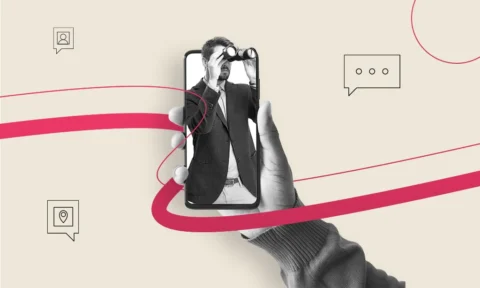App development has exploded in recent years. This has caused mobile applications to now become the standard for businesses and entrepreneurs alike, and it seems as though this trend is only picking up steam.
It is estimated that by 2022, annual mobile app downloads are set to reach over 258 billion–a 45% increase from 2017.
What this means is that mobile app development must be a part of your business model and strategy if you’re looking to attain long-term success in the 21st century.
And what is one of the most essential components of the mobile application? You guessed it! The form…
If your form is shoddy, tacky, an eyesore to look at, or anything else that weakens the user experience, this will negatively affect conversions, and ultimately, your bottom line.
With that in mind, here are a few elements to focus on in the mobile application development process to ensure you aren’t leaving anything on the table.
Design
The design of a mobile application form has many complex components. Let’s take a look at a few of them.
Appearance
The semblance of your mobile application design is extremely critical. The look, the feel, and the texture of it say a lot. It will also give your users a stark impression of your brand and business:
Shoddy and poor-quality designs will turn people off and send them elsewhere as it communicates a lack of professionalism.
While on the opposite side of that coin; a sleek and clean look will communicate both authority and credibility.
Other things to consider are: How does the text/password layout look? Does the structure of your form stand out? All of these little details matter.
What Are Deliverables?
App development can be a lengthy process, which means it needs milestones. That’s essentially what a ‘deliverable’ is.
It is a milestone you and your app developer agree on by a particular date during the mobile application creation process.
Deliverables can be as simple as design components such as logos, artwork, text, images, etc. And can also include more complicated files like codes, login credentials, and other documents.
Test the Usability of your Mobile Application
Users spend most of their time in apps when using their phones. So you’ll want to make sure yours, meets the required standard.
This can be accomplished via mobile application testing, and here are a few steps to do just that:
1. Draft the Intention
What is the aim of your test? What target are you trying to hit? Are you trying to enhance findability? Or assess how useful, entertaining, or helpful your app is?
Decide what the aim is and then on to the second step:
2. Start the Experiment
Whether you’re doing in-person or remote testing, you will want to watch the candidates doing the trial run in real-time. This is your best bet for uncovering any problems you may have missed.
By seeing their body language, as well as their gesticulation and physiology change in real-time, you’ll be better able to spot the troublesome nuances in the app that need to be modified.
3. Study the Results
Once you’ve amassed all the information you need, it is time to go back to the drawing board. Go over and review the results that the trial run divulged.
Look at how the participants reacted to the app, listen to their feedback, gather the details, facts, and figures, then use your best judgment to decide what must be done to improve moving forward.
The Importance of an Accessible Application
Ensuring that your app can be easily accessed is of paramount importance. Billions of people are now online, and even third-world countries are slowly becoming more connected.
As a result, businesses with accessible apps make more sales and gain more exposure than their app-less counterparts.
Current figures peg the number of smartphone users to be an estimated 6.4 billion people. And with a global population of about 7.9 billion–that 80% of people own a smartphone.
And to think; all it takes is having an operational mobile app to gain access to that staggering demographic.
One of the most powerful avenues for building a business in the 21st century is app development.
What’s the difference between CX and UX?
What is CX? CX is an acronym that stands for customer experience. And as for UX, this acronym stands for user experience.
CX (Customer Experience)
Customer experience focuses on the experience of the customer as it pertains to all aspects of the business. It is the general experience a customer has with the company as a whole.
For example, everything from the company’s advertising to the quality of their products to their pricing, even to the overall tone and feel of the brand are all taken into consideration as it relates to CX (the customer experience.)
In short, the CX is every exchange that a customer has with a particular brand, business, or organization.
UX (User Experience)
The user experience is more focused on those individuals who are interacting with a single product or service. Oftentimes the product is a site, a type of software, or in this case, a mobile app.
Many things can affect the user experience regarding a mobile app. But some of the strongest variables are the simple things that are well within your control.
Aspects such as product design, the responsiveness of the app, and the look and texture of it. All of these things play a part in the overall experience and must be taken into consideration.
Understanding the concepts of–and differences between–CX and UX is important to creating and launching a successful app that will delight customers.
How to Design Better Forms in Your Mobile Applications
Quality forms that are well-designed and easy to fill out make for a good user experience. Forms that lack these traits often frustrate users, which in turn, causes them to become annoyed and abandon the site.
Your mobile forms do not need to be complicated or ostentatious. It’s much better if they’re simple, easy, and convenient.
Here are a few suggestions to help increase conversions by creating a more user-friendly experience for your customers:
1. Reduce Form Fields
Remember, you want this process to be effortless. That means you want as little resistance as possible, and adding unnecessary form fields doesn’t help to achieve this goal.
Unless it is an absolute necessity: first and last name, email, etc. Then leave it out. Anything above the necessities just creates clutter in your form.
Additionally, be sure that all the form fields are labeled and legible.
2. Single Column Layout
If you happen to be creating a longer field form, be sure to opt for the single-column layout. A clear, clean, and immaculate format will do more for your professionalism and credibility than a cluttered design any day.
This layout is also less intimidating to the reader, so, therefore, it is more likely to get completed.
Also, keeping with the theme of form simplicity, don’t divide data fields. For example, instead of having two field forms asking for the first and last name, opt for the second approach of one field form asking for the full name instead.
The more effort you require the user to expand to fill out the form, the less likely that form will get filled out. Always opt for simplicity.
3. Clear CTA (Call-to-Action) Button
After filling out a form (especially if it was particularly long), adding a direct, bold CTA button clearly instructs users of the next step.
It’s a simple–and often, obvious–addition that helps to strengthen the user experience.
Tiny tweaks and adjustments such as this are the little nuances that help make the process smooth and effortless for the reader/customer.
Mobile Design Creation Procedure
Mobile application design is an important procedure. With the right app development, your business can be taken to new heights.
There are a few steps to keep in mind when beginning this process:
1. Formulate a Plan
You will need a strategy, a plan. Some type of framework you can follow to help guide you through the process. The strategy for your app will be predicated on the goals of your business.
What are your main business goals at the moment? Are you trying to grow your customer base? Bolster the relationships with your existing customers? Improve visibility and brand awareness?
What are you aiming at? Once you’ve pinpointed what your most pressing objectives are, then you lay the framework for the app creation process based on your business needs.
2. Business Mobile App Strategy
The app is going to rise or fall based on the quality and soundness of the strategy… no pressure. But try to understand the importance of a good app plan.
A good way to begin this process is through questioning. Specifically, by asking: how is this app going to benefit the user?
Determine how the mobile application design is going to help and be of service before moving on.
3. The Right Tools for the Job
Next, you will need to decide what mobile design tools you want to use. Some of the most well-liked are Adobe XD, Adobe Photoshop, and Visual Studio Code, among others.
However, when it comes to mobile app designs, Sketch is often considered to be the standard among developers.
Of course, these are just suggestions. Be sure to do your own research to find out what you’re most comfortable with and what works best for you.
How Much Does it Cost to Design a Mobile Application?
You may be wondering to yourself at this point: how much does it cost to design a mobile app? The answer is–it varies.
The cost of an app in 2021 on the low end of the spectrum is about $5000 to $10,000.
The average or medium cost can be in the range of $35,000 to as high as $175,000. And if you’re feeling particularly extravagant and have the means to do it; high-quality app development can be as much as $500,000 or more.
Other factors that will affect the cost of app development include: the timeline/schedule you’re on, the scope of the job, and even the country you live in will be a contributing factor in the price tag of your mobile app development.
What is the Importance of Mobile Optimization?
Mobile optimization is the key component that is responsible for reaching a broader market on the internet. It is essentially the process of enhancing your website’s functionality across multiple devices or platforms.
What this entails is that your site still looks appealing and professional whether you’re on a desktop, laptop, tablet, or smartphone.
The Benefits of Mobile Optimization
The technological landscape is constantly changing. And make sure you are up to date via mobile optimization safeguards you are your business from getting left behind.
Here are just a few other benefits of mobile optimization:
SEO
If users don’t bounce from your site on their mobile devices, Google will take this as a sign that your site is authoritative with high-quality content. This will push you further up in the rankings providing you with more visibility.
Status and Rank
When accessing your site via their mobile devices, are users hit with a plethora of site issues? Slow site loading time, out-of-date design, broken links, etc.
These problems can severely impact the experience for mobile users and affect your company’s reputation.
Consumer Satisfaction
The primary objective of mobile optimization is to enhance the customer experience while they traverse through your site on their mobile devices. This makes them want to return and become repeat customers as it builds trust and credibility.
The Power of Mobile Applications
There is a massive amount of work associated with creating or improving mobile applications. But it is all worth it.
Because the fact of the matter is, in this digital age that we find ourselves in, mobile apps are becoming increasingly important (and necessary) to the lifeblood of businesses, organizations, and brands.
If you are interested in learning more, be sure to visit the blog or contact us with any questions you may have.



